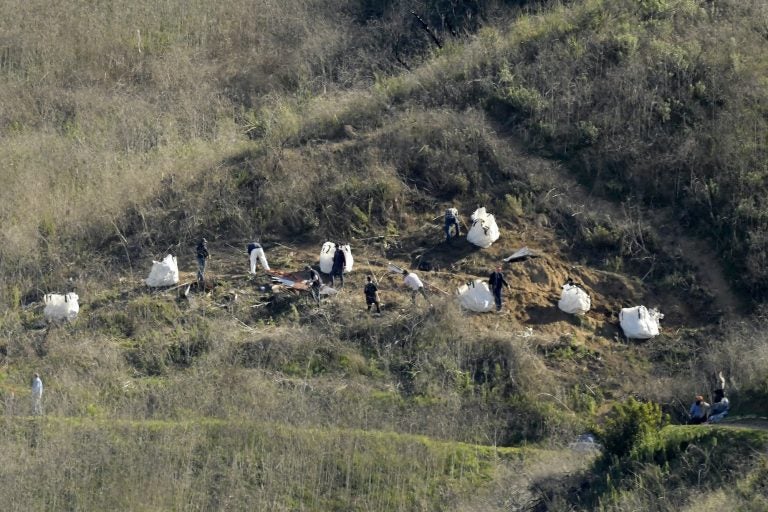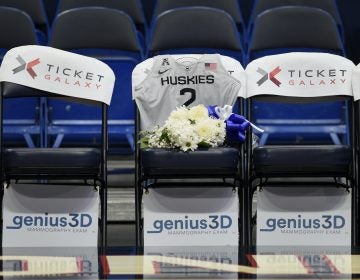Was Kobe Bryant’s pilot feeling pressure to fly that day?
The veteran pilot whose helicopter plunged into a Los Angeles-area hillside, killing Kobe Bryant and eight others, had tried to avoid fog so heavy that it had grounded police

Investigators work the scene of a helicopter crash that killed former NBA basketball player Kobe Bryant, his 13-year-old daughter, Gianna, and seven others Monday, July 23, 2018, in Calabasas, Calif. (Mark J. Terrill/AP Photo)
Updated 6:13 p.m.
The pilot in the foggy-weather helicopter crash that killed Kobe Bryant was well-acquainted with the skies over Los Angeles and accustomed to flying celebrities.
Ara Zobayan, 50, had spent thousands of hours ferrying passengers through one of the nation’s busiest air spaces and training students how to fly a helicopter. Friends and colleagues described him as skilled, cool and collected, the very qualities you want in a pilot.
His decision to proceed in deteriorating visibility, though, has experts and fellow pilots wondering if he flew beyond the boundaries of good judgment and whether pressure to get his superstar client where he wanted to go played a role in the crash.
Jerry Kidrick, a retired Army colonel who flew helicopters in Iraq and now teaches at Embry-Riddle Aeronautical University in Prescott, Arizona, said there can be pressure to fly VIPs despite poor conditions, a situation he experienced when flying military brass in bad weather.
“The perceived pressure is, ‘Man, if I don’t go, they’re going to find somebody who will fly this thing,’” Kidrick said.
Bryant, his 13-year-old daughter Gianna and six other passengers were killed along with the pilot Sunday morning when the chartered Sikorsky S-76B plowed into a cloud-shrouded hillside in Calabasas as the retired NBA star was on his way to a youth basketball basketball tournament in which Gianna was playing.. The last of the nine bodies was recovered Tuesday.
National Transportation Safety Board investigators have said Zobayan asked for and received permission from air traffic controllers to proceed in the fog. In his last radio transmission before the helicopter went down, he reported that he was climbing to avoid a cloud layer.
Investigators have yet to establish the cause of the crash and have not faulted his decision to press on or explained why he chose to do so.
Randy Waldman, a Los Angeles helicopter flight instructor who viewed tracking data of the flight’s path and saw a photo of the dense fog in the area at the time, speculated that Zobayan got disoriented in the clouds, a common danger for pilots.
He said Zobayan should have turned around or landed but may have felt the pressure to reach his destination, an occupational hazard for pilots often referred to as “got-to-get-there-itis” or “get-home-itis.”
“Somebody who’s a wealthy celebrity who can afford a helicopter to go places, the reason they take the helicopter is so they can get from A to B quickly with no hassle,” Waldman said. “Anybody that flies for a living there’s sort of an inherent pressure to get the job done because if too many times they go, ‘No, I don’t think I can fly, the weather’s getting bad or it’s too windy,’ … they’re going to lose their job.”
Helicopter pilot Kurt Deetz said he flew Bryant dozens of times over a two-year period ending in 2017, often to games at Staples Center, and never remembered the Lakers star or his assistants pressing him to fly in bad weather.
“There was never any pressure Kobe put on any pilot to get somewhere — never, never,” Deetz said. “I think he really understood professionalism. `You do your job. I trust you.’”
Deetz said that he flew with Zobayan a half-dozen times and that he was familiar with airspace and terrain around Los Angeles and knew “the back doors” — alternative routes in case of trouble, such as changes in the weather.
Others who knew Zobayan praised him as unflappable and skilled at the controls.
“Helicopters are scary machines, but he really knew what he was doing,” said Gary Johnson, vice president of airplane parts manufacturer Ace Clearwater Enterprises, who had flown with Zobayan about 30 times in roughly eight years. “I wouldn’t do it unless he was the pilot.”
The NTSB’s Jennifer Homendy said investigators in the crash that killed Bryant will be looking at everything, from the pilot’s history and actions to the condition of the helicopter. “We look at man, machine and the environment,” she said. “And weather is just a small portion of that.”
Zobayan, was chief pilot for the craft’s owner, Island Express Helicopters. He also was a flight instructor, had more than 8,000 hours of flight time and had flown Bryant and other celebrities several times before, including Kylie Jenner.
Island Express has had three previous helicopter crashes since 1985, two of them fatal, according to the NTSB’’s accident database. All involved flights to or from the company’s main destination of Santa Catalina Island, about 20 miles off the Southern California coast.
In 2008, three people were killed and three injured when an Island Express helicopter was destroyed as it came in for a landing on the island. Investigators said the chopper lost power, probably as a result of cracking in turbine blades inside the engine.
In 1985, an Island Express helicopter returning from the island collided with another chopper near a landing pad in Los Angeles. One person died and 11 were injured.
The Federal Aviation Administration warns helicopter pilots that it is their job to decide whether to cancel a flight because of bad weather or other risks, and to have a backup plan in case weather worsens during the flight.
Bret Mosher, a commercial jet pilot in the Los Angeles area, said some plane owners pressure him to fly solo rather than with the added expense of another pilot.
“Typically these owners, they are successful people in business, they’re type-A personalities. They are make-it-happen, get-it-done personalities,” Mosher said. “A couple of them have said half-joking and half-serious -– well, probably more than half-serious — ‘Aren’t you tough enough?’ or ‘Aren’t you trained well enough?’ or ‘Aren’t you good enough?'”
Associated Press writers Justin Pritchard and Stefanie Dazio in Los Angeles contributed to this story.
WHYY is your source for fact-based, in-depth journalism and information. As a nonprofit organization, we rely on financial support from readers like you. Please give today.




